Last updated: July 30, 2024
Article
Genetic Diversity of Wind Cave's Bison Herd
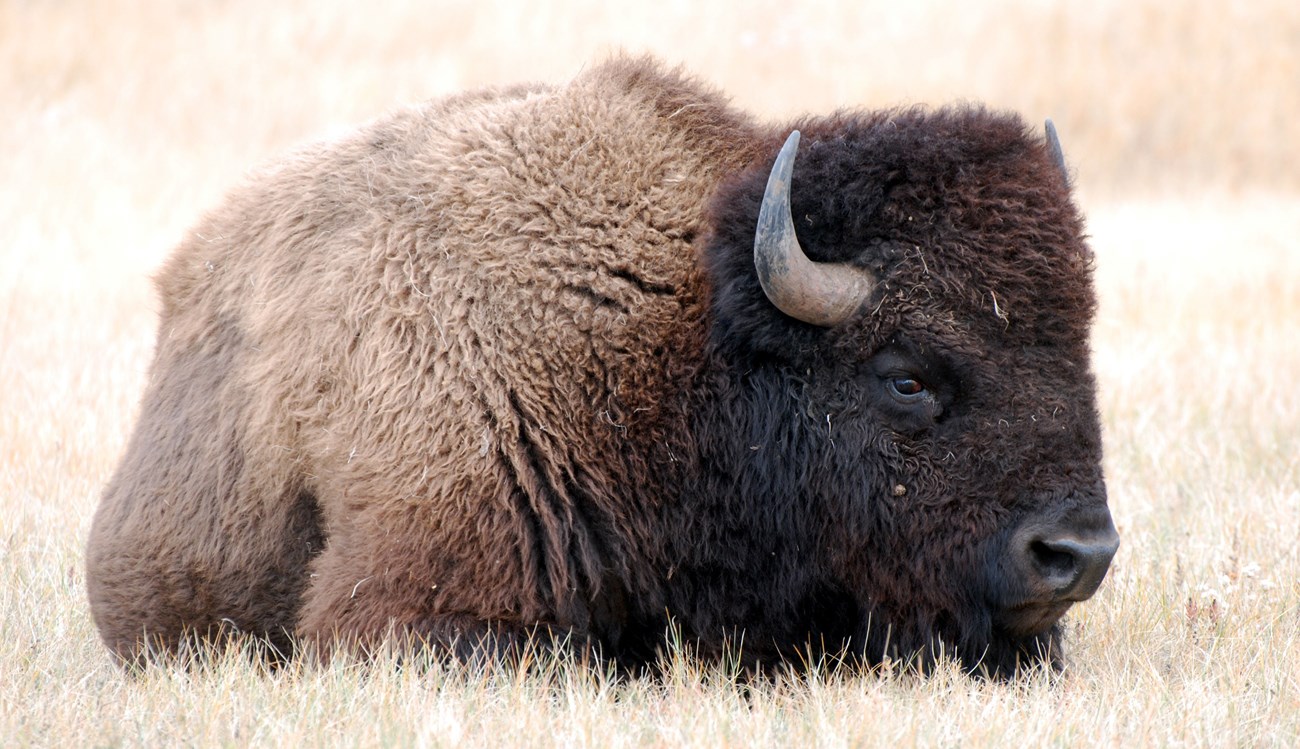
NPS Photo
Prior to the 1800s, North America’s bison population is estimated to have been in the tens-of-millions. As homesteaders moved farther west in the United States, the bison population dropped drastically due to hunting and loss of habitat. By 1880, the population decreased to the hundreds, spurring bison conservation efforts to prevent extinction of the species. A small amount of wild bison remained in places like Yellowstone National Park. Some ranchers and organizations owned small private herds, as well. Bison from these public and private herds became the basis for re-establishing bison populations throughout their historic range.
While repopulation has effectively saved bison from potential extinction, two factors that hinder conservation and preservation of bison today include cattle introgression and inbreeding depression, both of which can lead to loss of genetic diversity. These issues have been a focus of natural resource managers and bison management plans in recent years.
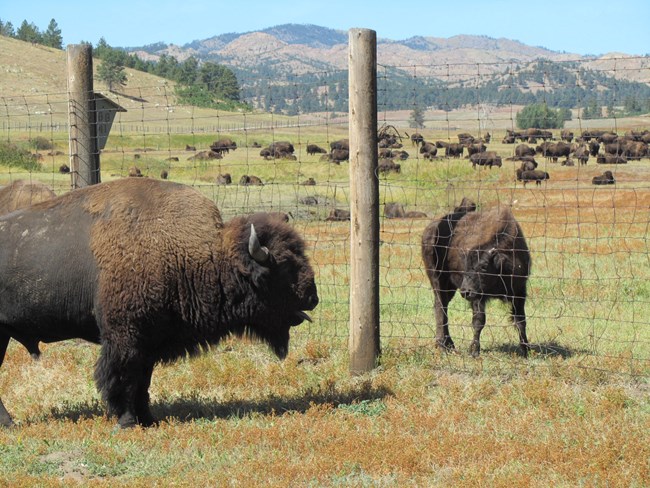
NPS Photo
Cattle Introgression
When the bison population plummeted into the hundreds, private herd owners bred bison and cattle together to grow bison populations. As a result, cattle genes appeared in the bison genome. Relocation of privately-owned bison with cattle introgression to public lands allowed for cattle genes to spread to new populations. This legacy of cattle genes, still evident in herds today, makes preserving a “pure” bison a harder goal for resource managers to accomplish.
Natalie D. Halbert and James N. Derr conducted multiple studies investigating cattle introgression within bison herds managed by the Department of the Interior (DOI). In a 2006 study, park staff collected bison tissue, hair, and blood from 11 US federal herds, including Wind Cave National Park, to analyze DNA from the mitochondria and nucleus of the cell for evidence of cattle introgression. In initial tests, the National Bison Range herd in Montana is the only one out of 11 tested herds to show evidence of introgression. Bison from this herd have been relocated to grow other DOI-managed populations, so these herds may have cattle genes as well.
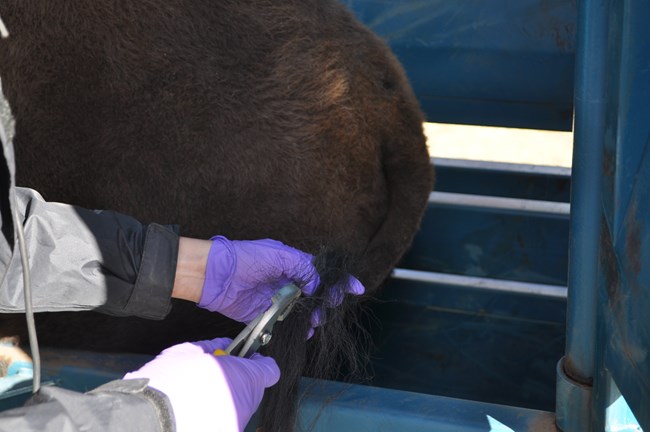
NPS Photo
Additional testing in this study revealed evidence of introgression in seven out of 11 DOI herds. Where possible, researchers sampled every bison in a herd, achieving a total of 3301 samples. Bison herds tend to be small, which makes statistically confident results difficult, so further testing should be conducted for some federal herds. Wind Cave and Yellowstone National Parks are the only two federal herds to have population sizes large enough for sufficient testing. Both herds show no evidence of cattle introgression.
Inbreeding Depression
In 1912, the Wind Cave National Game Preserve was created to restore the bison population at Wind Cave National Park. The New York Zoological Society sent 14 bison in 1913 and by 1930, the population had grown to 200. The park now manages the population to be between 350-500 bison, a size that can be sustained by park resources. From a genetic standpoint the herd is small and isolated, raising the concern of inbreeding depression. Like cattle introgression, inbreeding depression can cause a loss of genetic diversity, making it harder for bison to reproduce and survive.
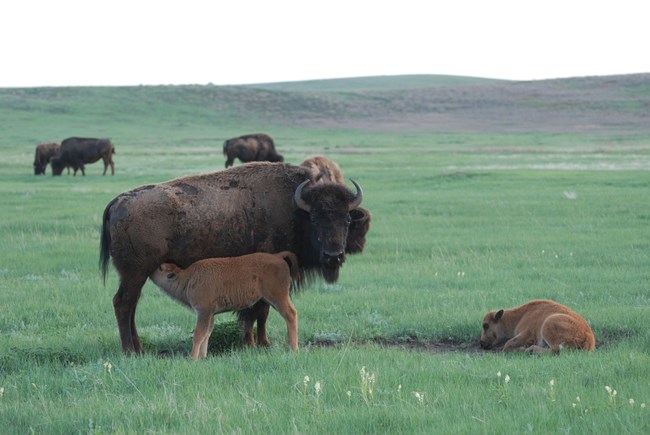
NPS Photo
Daniel S. Licht conducted a study to identify evidence of inbreeding depression in small and isolated herds in national parks (2017). Licht ran multiple tests using different variables to pinpoint specific evidence of inbreeding depression. One test used population growth and reproduction rates to create historical and future simulations of bison herd populations. Comparisons between simulations and recorded data showed no evidence of inbreeding depression.
A second test used a range of lethal equivalents, the number of deleterious alleles in an organism’s genes due to inbreeding, to show signs of inbreeding depression. As lethal equivalents increase, the modeled population decreases and is much lower than the recorded population. Licht found when lethal equivalents equal zero, the modeled yearly populations were almost identical to the recorded yearly populations. This shows that the current bison herd at Wind Cave National Park does not contain alleles that would lead to inbreeding depression.
Bison Management
For cattle introgression, DOI and public herds are grouped in four classes, each with their own specific management recommendations:
| Class | Recommendation |
|---|---|
| No molecular evidence of cattle introgression | These herds should be protected from unintentional introgression. Yellowstone and Wind Cave herds are the only DOI herds with no evidence of introgression. No mixing of herds should be allowed at this point in time. |
| Molecular evidence of cattle introgression | They should not be mixed with herds with no evidence of introgression but should be managed to preserve genetic variation. |
| Historical suggestion of cattle ancestry | Better testing may be able to reveal ancestry, but these herds should still be protected. |
|
Molecular evidence of high levels of cattle ancestry |
Only applies to herds that are not under DOI management. If these herds are near DOI herds, they should be watched to prevent mixing and genetic monitoring is important. |
For inbreeding depression, DOI and public herds are grouped in three classes, each with their own specific management recommendations:
| Class | Recommendation |
|---|---|
| Bison herd population is greater than 1000 | This class only applies to the Yellowstone herd. It is recommended to monitor impacts of current culling practices. |
|
Bison herd population is between 500 and 1000 |
Three DOI herds are this size. Herds should be managed to have no cattle introgression or inbreeding depression, and herds should be increased to 1,000 bison. |
| Bison herd population is less than 500 | Immediate action needed. Maintain population size but focus on maximizing number of breeding males, increasing genetic diversity, and genetic monitoring. |
The DOI Bison Conservation Initiative began in 2008 and has been updated over the years as needs of the bison population change. The 2020 report outlines five goals for the initiative: 1) wild, healthy bison herds, 2) genetic conservation, 3) shared stewardship, 4) ecological restoration, and 5) cultural restoration.
Four actions can be taken to accomplish these goals. The first action requires developing and launching a DOI bison metapopulation strategy. The second action requires developing and implementing a DOI bison stewardship plan. These two actions help put into words what the DOI and partnering agencies are planning to do based on current data. The third action will improve and expand mechanisms to support ecocultural restoration of live bison. The fourth action is to adopt low stress capture and handling practices of bison.
Overall, the initiative supports a collaborative approach to bison conservation to ensure the genetic, ecological, and cultural importance of this species is maintained and preserved for future generations.
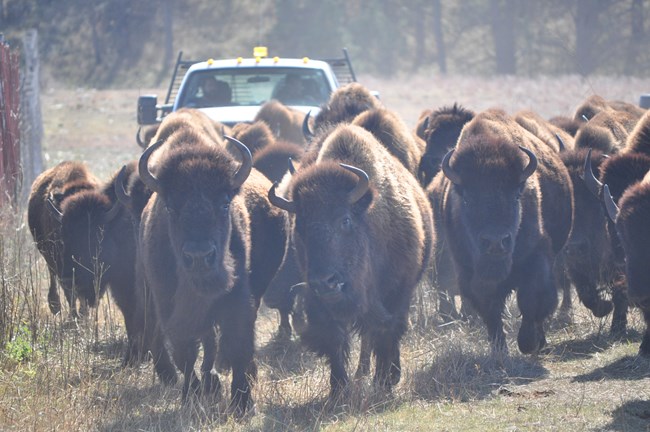
NPS Photo
Summary
Nationally, the bison population has grown significantly, but most herds remain small and isolated. Current management goals focus on a holistic approach to ensure that the health of bison, their habitat, and their cultural importance is protected. As more data becomes available and populations grow, bison management will continue to adapt to preserve the species.
Sources
Dratch, P. A., and P. J. P. Gogan. Bison Conservation Initiative: Bison Conservation Genetics Workshop: report and recommendations. Natural Resource Report NPS/NRPC/BRMD/NRR—2010/257. National Park Service, Fort Collins, Colorado.
Halbert, Natalie D., and Derr, James N. A Comprehensive Evaluation of Cattle Introgression into US Federal Bison Herds, 2006.
Halbert, Natalie D., Gogan, Peter J.P., Hiebert, Ronald, and Derr, James N. Where the Buffalo Roam: The Role of History and Genetics in the Conservation of Bison on U.S. Federal Lands, 2007.
Licht, Daniel S. Bison Conservation in Northern Great Plains National Parks: No Need to Panic, 2017.
Symstad, A. J., B. W. Miller, T. M. Shenk, N. D. Athearn, and M. C. Runge. 2019. A draft decision framework for the National Park Service Interior Region 5 bison stewardship strategy. Natural Resource Report NPS/MWRO/NRR—2019/2046. National Park Service, Fort Collins, Colorado.
